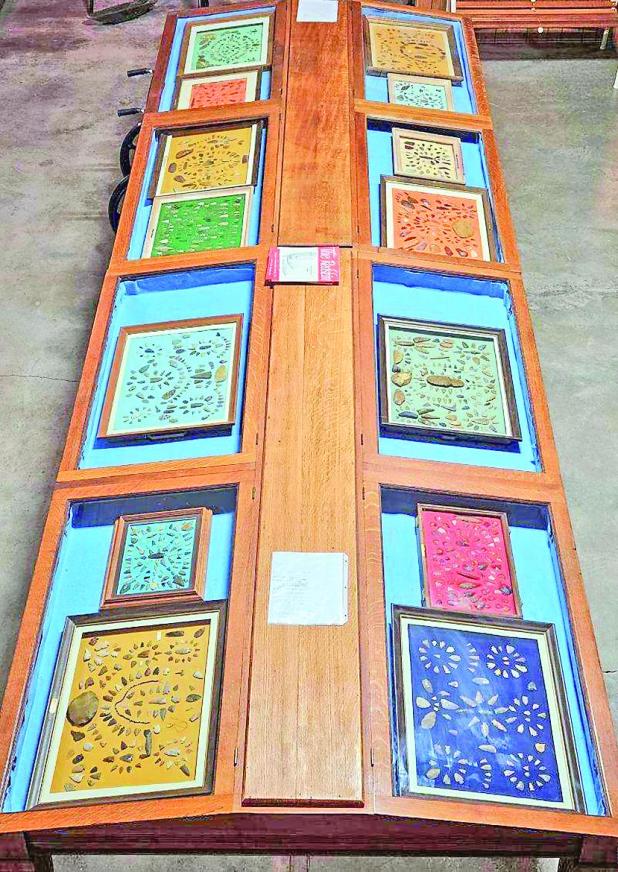
Courtesy photo
These 14 framed Native American artifact collections belonging to the Jon Welch family have been loaned and are on display at the Chase County Museum.
Chase County Museum is new home to local family’s devotion to history
Jon Welch and family of Champion has carried on a long family tradition of hunting and collecting Native American artifacts to commemorate and pay respect to the history of Indian tribes that lived and passed through this area.
The Welchs have decided to share the culmination of a lifelong passion by permanently loaning their large assemblage of artifacts to the Chase County Museum. The display is comprised of mostly arrowheads, but also includes knives, scrapers and beads left by a number of Native American tribes, including Pawnee, Sioux and Cheyenne.
There are 14 frames of projectile points and stone implements made by the original inhabitants of the area.
“All of the artifacts were found in Dundy and Perkins Counties, some in Phillips County, Colorado, but the majority were found in Chase County,” said Welch.
He added that family members hunted and found every single artifact in the collection themselves. They never purchased any of them.
He said many collectors prefer to keep their arrowhead collections to themselves as his family also did over the many decades.
“I wanted to promote Native Americans and their amazing work—how they survived and lived,” Welch said, “I felt their history needed to be remembered. It is important to have for future generations.”
A brief history
Growing up, Welch said he always had an interest in archaeology, artifacts and history.
Welch, with his parents, Don and Jean Welch, brother, Jim and his aunt, Nina Fortkamp, started hunting arrowheads as a family activity when arrowhead hunting became popular in the 1960s and early 70s.
“My aunt actually had been hunting arrowheads all of her life, so she was very knowledgeable. My mom found the most artifacts. She seemed to be able to just zone in and see them,” Welch said laughing.
The family would work at the family-owned grocery store in Champion six days a week, but early Sunday mornings, they would pack lunches and go spend the day hunting. Sometimes friends of the family enjoyed hunting with them, he said.
“It was a great family activity. We enjoyed spending time together, and it was good exercise,” Welch chuckled again. “I have wonderful memories.”
There used to be thousands of buffalo that came through the area. Most of the tribes were nomadic and followed the herds, he added.
He also mentioned that there used to be a lot more water in the area that game would frequent. Welch said arrowheads could be found around those areas where Indians hunted.
“Back when my family started hunting for artifacts, all the fields were dryland farmed where dirt would often blow making it easier to find arrowheads as they were uncovered. When pivots began showing up on fields, it reduced the amount of blowing dirt making the arrowheads harder to find,” said Welch.
“It always amazed me to find a perfect arrowhead in a field, especially after it had been farmed, yet they still showed up for us to find,” he added. “It was pure joy to find an arrowhead in one piece.”
“Our family had no idea of the size the collection would become when we first started.”
White settlers only started homesteading in this area in the 1880s, but there have been numerous artifacts found over the years because Native Indians have hunted here for thousands of years—especially around water sources, he said.
“Some arrowheads found here have been documented to be 7,000 to 10,000 years old,” he continued.
You can still find arrowheads today, but if you ask hunters where they go to find artifacts, most won’t tell the location. They keep that information to themselves, said Welch.
“I still go hunting occasionally if I see a place that the dirt has blown,” he said.
Of the 14 framed artifacts, five of them belonged to Welch’s Aunt Nina. He became custodian of them when she passed away.
Charley Colton, president of the Chase County Historical Society, said as long as the museum is open and operating, the collection will remain housed in the museum. If the museum would ever close, the collection will go back into the possession of the Welch family.
“The museum had to rearrange several displays to provide a space large enough for this fantastic collection. This addition to our already nice collection of locally collected artifacts give a nice history of the very earliest inhabitants of Chase County,” Colton said.
